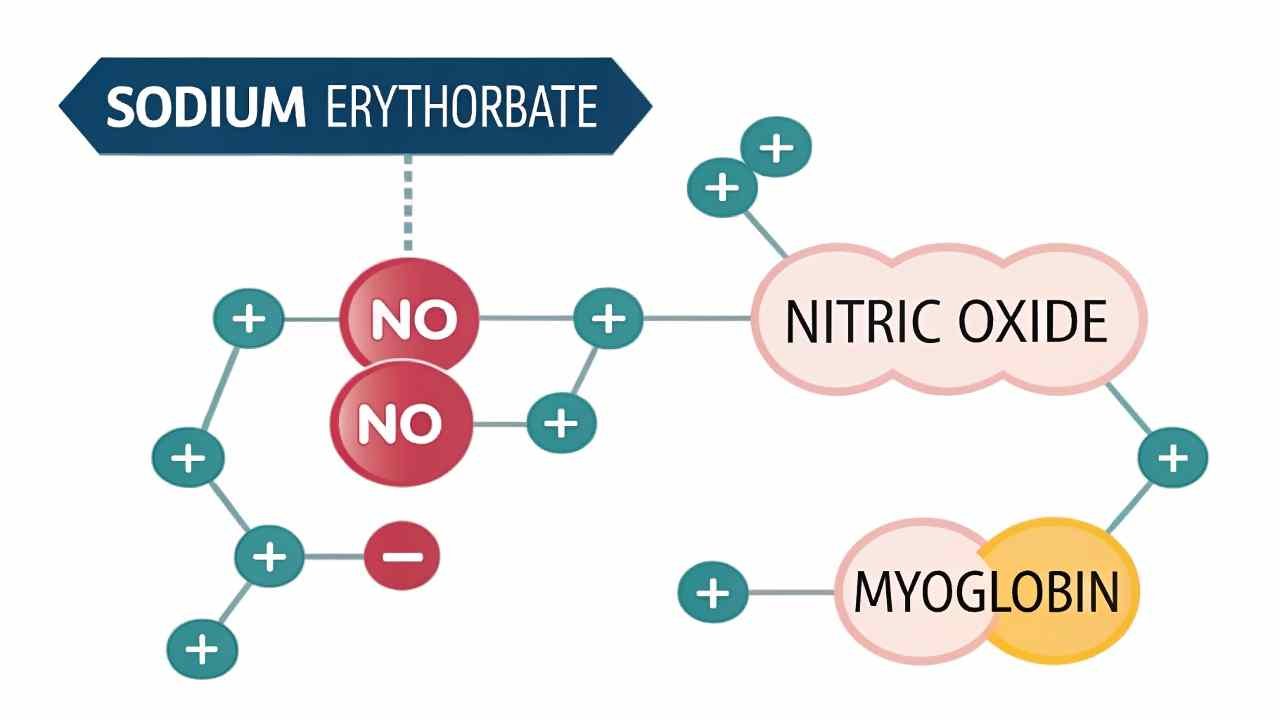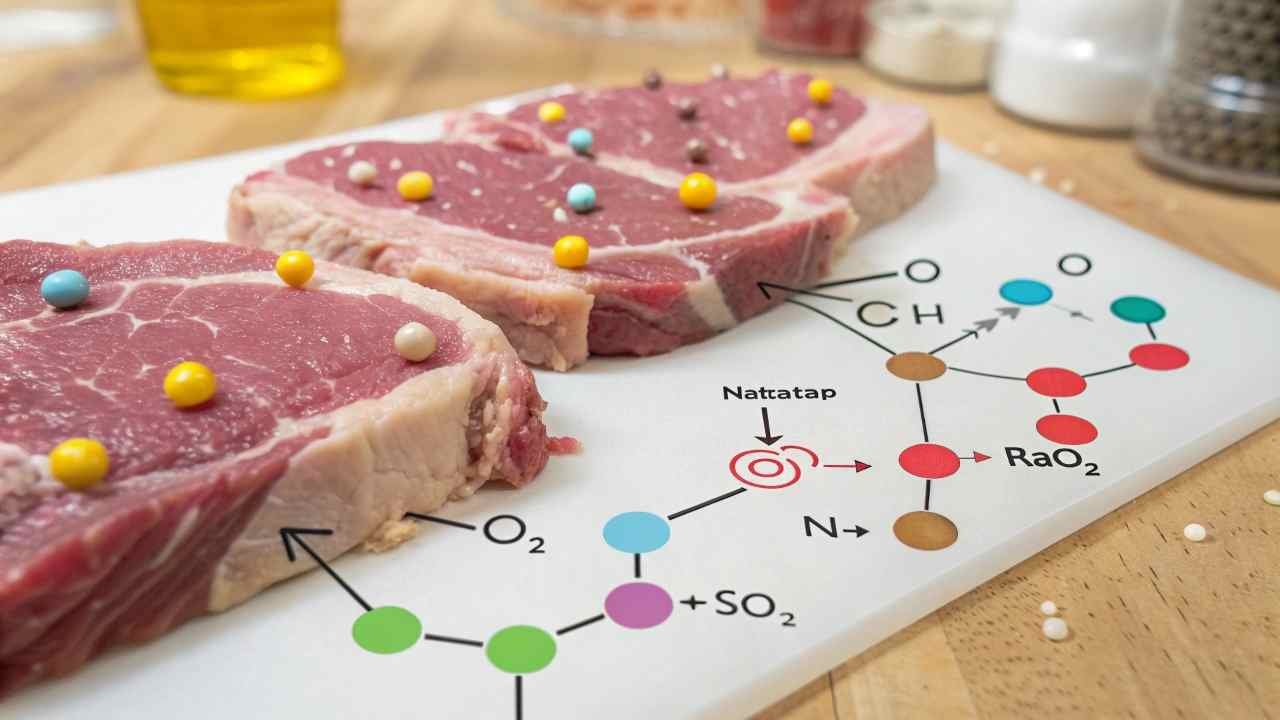Struggling with meat color or flavor issues? Need to keep processed meats fresh and appealing? Sodium erythorbate can be a game-changer for meat quality.
Sodium erythorbate, an antioxidant, boosts meat quality by speeding up cure color, keeping the red color bright, stopping off-flavors from fat rancidity, and improving product stability.
At FINETECH, we see meat processors needing better products. Quality and shelf life are key. Clients demand top ingredients. Sodium erythorbate delivers. Let's see how.
Why Does Sodium Erythorbate Maintain the Red Color in Processed Meats?
How do cured meats stay red? Why don't they turn grey? Sodium erythorbate is key for that attractive, stable color.
Sodium erythorbate keeps meats red by speeding up nitrite's change to nitric oxide. This reacts with myoglobin to form stable pink nitrosomyoglobin and prevents this color from fading.

Good color means freshness to consumers. Sodium erythorbate, a "cure accelerator," is vital for this in processed meats.
The desired pink color in cured meats (ham, bacon) comes from nitrosomyoglobin1. This forms when nitric oxide (NO) from sodium nitrite2 reacts with meat's myoglobin. Sodium erythorbate quickly converts nitrite to NO. Without it, color development is slow and poor.
It also stabilizes this pink color by scavenging oxygen, preventing the pigment from oxidizing and turning brown. This means a longer shelf life with good color. While mainly for cured meats, it offers some color protection in uncured fresh meats too by slowing browning.
Color Maintenance Role:
| Action | How Erythorbate Helps | Result |
|---|---|---|
| Speeds NO Formation | Quickly changes nitrite to nitric oxide | Faster pink color development |
| Stabilizes Color | Protects pink pigment from oxygen | Longer lasting, stable color |
| Delays Browning | Slows myoglobin oxidation | Fresher look for longer |
How Does Sodium Erythorbate Prevent Off-Flavors in Meat Products?
Worried about stale or rancid tastes in meat? Want to keep it tasting fresh? Sodium erythorbate stops those bad flavors.
Sodium erythorbate stops off-flavors by preventing fat oxidation (rancidity). As an antioxidant, it fights oxygen and free radicals that degrade fats, causing bad odors and tastes.

Off-flavors, often from fat going rancid (lipid oxidation3), ruin meat. Sodium erythorbate, a strong antioxidant, stops this.
It works by:
- Scavenging Oxygen: Reacts with oxygen so it can't attack fats.
- Neutralizing Free Radicals: Stops the chain reaction of fat breakdown.
This is very helpful in fatty meats like poultry (dark meat), pork products (sausages, bacon), and ground meats. It also helps prevent "warmed-over flavor" in reheated cooked meats. By stopping these bad compounds, sodium erythorbate keeps the meat's original flavor fresh longer. This improves quality and shelf life.
Flavor Protection Summary:
| Issue Avoided | Erythorbate's Action | Benefit |
|---|---|---|
| Rancid Flavors | Stops fat oxidation | Fresh taste, longer shelf life |
| Warmed-Over Flavor | Reduces oxidation in reheated cooked meats | Better quality for pre-cooked |
Can Sodium Erythorbate Be Used in All Types of Meat Processing?
Is sodium erythorbate only for certain meats? Or is it more versatile? Let's see where it can be used.
Sodium erythorbate is used in many processed meats: cured items (sausages, ham), cooked sausages, poultry products, and even some fresh ground meats to slow discoloration and rancidity.

Sodium erythorbate is very versatile. Its main uses are:
- Cured Meats (Ham, Bacon, Sausages, Hot Dogs): Its primary role. Speeds cure color, stabilizes it, and prevents rancidity.
- Cooked Sausages/Deli Meats (Uncured/Low-Nitrite): Prevents off-flavors (like warmed-over flavor) and helps retain some color.
- Poultry Products (Ground, Patties): Delays rancidity, extending shelf life and keeping flavor good. Also helps color.
- Fresh Meats (Limited): Can sometimes be used on ground meats or cuts to slow browning and early rancidity. Regulations vary.
It can also be used in some processed fish products. The key is that its antioxidant and cure-accelerating properties are valuable across many applications. FINETECH ensures clients know typical uses.
Application Versatility:
| Meat Product Category | Key Benefit(s) of Sodium Erythorbate | Example Products |
|---|---|---|
| Cured Meats (Nitrite-Cured) | Cure Acceleration, Color Stability, Flavor Protection | Ham, Bacon, Sausages, Hot Dogs, Jerky |
| Cooked Sausages/Deli Meats | Flavor Protection (Anti-Rancidity), Color Retention | Chicken Sausage, Roast Beef, Turkey Slices |
| Poultry (Ground/Processed) | Flavor Protection (Anti-Rancidity), Color Retention | Ground Turkey, Chicken Patties |
| Fresh Ground Meats (Limited) | Color Retention (Anti-Browning), Early Rancidity Delay | Ground Beef (where permitted), Fresh Sausage |
| Processed Fish/Seafood | Flavor Protection, Color Retention | Smoked Fish, Canned Fish (less common than meat) |
Does Sodium Erythorbate Work Better with Nitrites in Cured Meats?
Using sodium erythorbate with nitrites? How do they work together? Let's clarify this powerful synergy.
Yes, sodium erythorbate and nitrites are a great team. Erythorbate acts as a "cure accelerator," rapidly changing nitrite to nitric oxide, which is vital for good cured meat color and flavor.

The sodium nitrite + sodium erythorbate combo is key in modern cured meats. Erythorbate greatly speeds up the change of nitrite (NO2-) to nitric oxide (NO). Nitric oxide then forms the stable pink cured color (nitrosomyoglobin) with meat's myoglobin.
Benefits of this teamwork:
- Faster Curing: Quicker color means shorter processing, better efficiency.
- Consistent Color: More uniform and stable pink color.
- Less Residual Nitrite: More nitrite is used effectively, leaving less behind.
- Inhibits Nitrosamines: Erythorbate helps block the formation of potentially harmful nitrosamines (a safety plus).
Erythorbate also adds its own antioxidant power to protect against rancidity and color fading, complementing nitrite's own effects. This synergy makes them essential in the cured meat industry4.
Nitrite & Erythorbate Teamwork:
| Aspect | Nitrite Role | Erythorbate Boost | Combined Win |
|---|---|---|---|
| Cure Color | NO Source | Speeds NO formation | Fast, stable pink color |
| Nitrosamines | (Precursor risk) | Blocks nitrosating agents | Reduced nitrosamine risk |
| Efficiency | (Slow alone) | Speeds color reaction | Shorter cure time |
Is Sodium Erythorbate Cost-Effective for Meat Manufacturers?
Watching costs? Is sodium erythorbate worth the expense? Let's look at its value for meat producers.
Yes, sodium erythorbate is very cost-effective. Small amounts provide big benefits: faster processing, better color, longer shelf life, and flavor protection, giving excellent value for money.

For any meat processor, managing costs while maintaining quality is a constant balancing act. Additives must justify their expense by delivering tangible benefits. Sodium erythorbate scores highly on this front for several reasons.
- Low Use Levels: Effective at small amounts (around 0.05%), so ingredient cost per unit is low.
- Faster Processing: Shorter cure times mean more plant output and lower energy use.
- Less Spoilage5: Prevents rancidity and color fade, extending shelf life and reducing waste.
- Better Quality: Good color and flavor mean happy customers and fewer complaints.
- Good Value vs. Alternatives: Often cheaper than other options like ascorbic acid for similar functions.
The true value is seen in overall efficiency, product quality, and reduced losses. FINETECH aims for competitive pricing so clients can fully benefit.
Value Breakdown:
| Erythorbate Benefit | Cost Saving / Value |
|---|---|
| Faster Curing | More output, less energy |
| Prevents Rancidity/Fade | Longer shelf life, less waste |
| Quality Improvement | Happy customers, fewer returns |
| Low Use Rate | Minimal ingredient cost |
Conclusion
Sodium erythorbate is vital for meat quality. It ensures great cured color, prevents off-flavors, works well with nitrites, and is very cost-effective for meat producers worldwide.
-
Understanding nitrosomyoglobin is crucial for grasping how cured meats achieve their characteristic pink color, enhancing your culinary knowledge. ↩
-
Exploring the effects of sodium nitrite will provide insights into its importance in meat curing processes and food safety. ↩
-
Understanding lipid oxidation is crucial for meat preservation and quality. Explore this link to learn more about its impact. ↩
-
Exploring trends in the cured meat industry can provide insights into innovations and consumer preferences in meat products. ↩
-
Discover effective methods to minimize spoilage in meat products, ensuring better quality and reduced waste for processors. ↩


